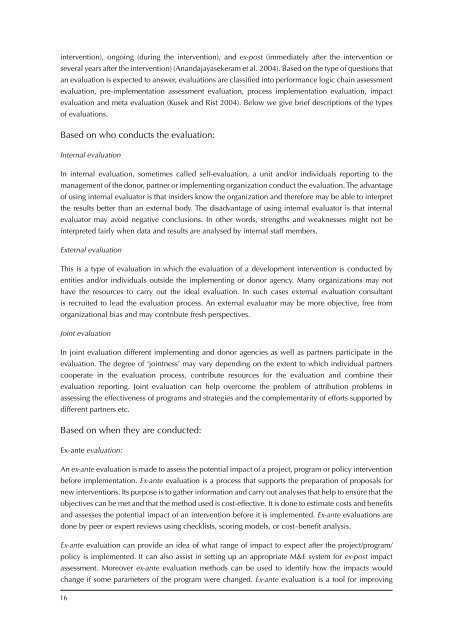A guide for practitioners
A guide for practitioners
A guide for practitioners
You also want an ePaper? Increase the reach of your titles
YUMPU automatically turns print PDFs into web optimized ePapers that Google loves.
intervention), ongoing (during the intervention), and ex-post (immediately after the intervention orseveral years after the intervention) (Anandajayasekeram et al. 2004). Based on the type of questions thatan evaluation is expected to answer, evaluations are classified into per<strong>for</strong>mance logic chain assessmentevaluation, pre-implementation assessment evaluation, process implementation evaluation, impactevaluation and meta evaluation (Kusek and Rist 2004). Below we give brief descriptions of the typesof evaluations.Based on who conducts the evaluation:Internal evaluationIn internal evaluation, sometimes called self-evaluation, a unit and/or individuals reporting to themanagement of the donor, partner or implementing organization conduct the evaluation. The advantageof using internal evaluator is that insiders know the organization and there<strong>for</strong>e may be able to interpretthe results better than an external body. The disadvantage of using internal evaluator is that internalevaluator may avoid negative conclusions. In other words, strengths and weaknesses might not beinterpreted fairly when data and results are analysed by internal staff members.External evaluationThis is a type of evaluation in which the evaluation of a development intervention is conducted byentities and/or individuals outside the implementing or donor agency. Many organizations may nothave the resources to carry out the ideal evaluation. In such cases external evaluation consultantis recruited to lead the evaluation process. An external evaluator may be more objective, free fromorganizational bias and may contribute fresh perspectives.Joint evaluationIn joint evaluation different implementing and donor agencies as well as partners participate in theevaluation. The degree of ‘jointness’ may vary depending on the extent to which individual partnerscooperate in the evaluation process, contribute resources <strong>for</strong> the evaluation and combine theirevaluation reporting. Joint evaluation can help overcome the problem of attribution problems inassessing the effectiveness of programs and strategies and the complementarity of ef<strong>for</strong>ts supported bydifferent partners etc.Based on when they are conducted:Ex-ante evaluation:An ex-ante evaluation is made to assess the potential impact of a project, program or policy interventionbe<strong>for</strong>e implementation. Ex-ante evaluation is a process that supports the preparation of proposals <strong>for</strong>new interventions. Its purpose is to gather in<strong>for</strong>mation and carry out analyses that help to ensure that theobjectives can be met and that the method used is cost-effective. It is done to estimate costs and benefitsand assesses the potential impact of an intervention be<strong>for</strong>e it is implemented. Ex-ante evaluations aredone by peer or expert reviews using checklists, scoring models, or cost–benefit analysis.Ex-ante evaluation can provide an idea of what range of impact to expect after the project/program/policy is implemented. It can also assist in setting up an appropriate M&E system <strong>for</strong> ex-post impactassessment. Moreover ex-ante evaluation methods can be used to identify how the impacts wouldchange if some parameters of the program were changed. Ex-ante evaluation is a tool <strong>for</strong> improving16

















